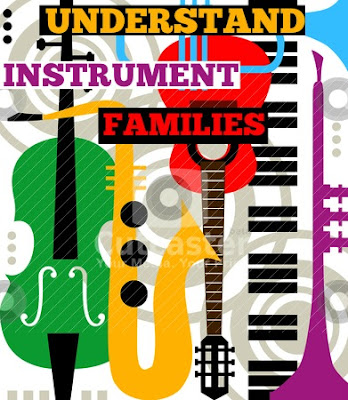 And, for the first time ever, all four of my own children happened to be home on a school break, which meant they played piano, ukulele, violin, trombone, saxophone, french horn and trumpet samples for my class. Although the variety of instruments around the world is huge, there are four categories/families of instruments found in the orchestra. Each family creates sound in a similar way. This interactive online orchestra lets you hear each family play its sound- just click on the section you'd like to sample.
And, for the first time ever, all four of my own children happened to be home on a school break, which meant they played piano, ukulele, violin, trombone, saxophone, french horn and trumpet samples for my class. Although the variety of instruments around the world is huge, there are four categories/families of instruments found in the orchestra. Each family creates sound in a similar way. This interactive online orchestra lets you hear each family play its sound- just click on the section you'd like to sample. Brass Instruments
Trombone, tuba, sousaphone, trumpet, and french horn are a few brass instruments.
But that's not the main reason these instruments are a family. I like to point out to my students that these instruments all make sound in a similar way. Yes, you put air into the instruments (aerophones), but not just by huffing and blowing. Brass instruments require the player to buzz the lips. The embouchure (the way in which a player applies the mouth) is a mouth with tight corners and loose lips in the center, creating a buzz that can be adjusted higher or lower in pitch. I invite all my students to experiment with buzzing, like with this short video to get the feel.
 Adjusting the buzz/embouchure creates an overtone series. A bugle, the simplest brass instrument, has no valves or slides. So, different notes are produced by adjusting the embouchure and the notes are limited to the overtone series.
Adjusting the buzz/embouchure creates an overtone series. A bugle, the simplest brass instrument, has no valves or slides. So, different notes are produced by adjusting the embouchure and the notes are limited to the overtone series. Other brass instruments have a few valves or a slide added, allowing the musician to play all notes of the chromatic scale. And what about the saxophone? It's made of brass for sure, but I never put it in the brass family because it is not a 'buzzed' instrument. Nowadays there are even brass instruments made of plastic. A pBone or pTrumpet is lightweight, durable, and kid-friendly (that means it doesn't get dents) but it is STILL a brass instrument with no brass to be found.
Because the embouchure is adjustable, much like the vocal cords, students need to have a good ear to know if they are hitting the correct pitch. Complete musicianship programs like Let's Play Music help develop the ear and prepare a student for success with brass. Here's a fabulous trumpet solo with some close-ups of the finger action to inspire youngsters who love brass:
Woodwinds
The woodwinds are clearly also aerophones (require air to play), but they present a lot of variety in look and sound. Bassoon, saxophone, piccolo, oboe, flute, and clarinet are a few woodwinds.
The name of this family leads everyone to wonder, "Are all of the woodwinds actually made of wood?"
The answer is that, yes, long ago all of these instruments were actually made of wood. Over time, some of these instruments have been replaced with metal or plastic. And then, around 1840, the saxophone was invented and considered part of this family because (as you now know) it just didn't belong in the brass family.
All sounds are created from vibrations. While brass instruments rely on the player's lip buzz to create the vibration, woodwinds generate vibration when air travels across a thin piece of wood, the reed, which vibrates. The clarinet and saxophone have one reed, the oboe and bassoon have two reeds, and the flute and recorder have no reeds (the air vibrates along the length of the tube).
This 7-minute video by House of Sound explains to kids how sound waves are set up in various woodwinds. You might enjoy watching their other videos, too.
Strings
Strings are chordophones (make sound by vibrating strings). Violin, viola, cello, bass, harp, and guitar are a few instruments from this family. The strings are made of nylon, steel, or gut, and the bodies of the instruments are hollow inside to allow the vibrations to resonate.
Strings are played most often by drawing a bow across the strings. The bow handle is made of wood and the strings are horsehair! Musicians can also pluck the strings with their fingers or tap the strings with the wooden side of the bow.
The Piano Guys love finding ways to get interesting sounds from a cello in unconventional ways. In this video, the deep bass drum sound is a bump on the body of the cello with a little help from some effects. The shaker sound was created by Steve rubbing rosin on his bow. The record scratch is Steve scratching a quarter on the strings. Check out all of Piano Guys videos and our Piano Guys interview, too.
Percussion
Percussion instruments are idiophones (makes sound when hit), or membranophones (makes a sound through the vibration of a stretched skin). Others make sounds when shaken or scraped. The worldwide list of percussion instruments is huge, but includes bongos, bass drum, snare drum, xylophone, cymbals, tambourine, maracas, gong, chimes, celesta, and piano.
Did you catch that I added piano to the percussion family? It's true that the piano has vibrating strings inside, so could possibly be considered a string instrument. This amazing brief animation shows the hammer action of the piano keys. When you press each key, a hammer taps the string and sets it to vibrating. When you release the key, a soft pad comes into place to stop the vibration. Because the instrument is played primarily by striking with varying levels of force, I think it fits best into the percussion family.
Piano falls into a sub-group of pitched (tuned) percussion instruments. Other instruments that can be tuned to play notes include ones with lots of notes like glockenspiel, marimba and bells, or ones with only a few notes, like timpani.
There are thousands of percussion instruments, and you have some with you right now! Hand-clapping and finger-snapping are percussion instruments, too. A child's percussive body is the best first instrument to master, so we encourage lots of patting, tapping, and dancing as a foundational skill for learning to play all of the other instruments you've read about in this post. I took my kids to see STOMP LIVE and we loved how they made percussive music from found everyday objects. Check out this video that takes hand-clapping and foot-stomping to an amazing level:
Timbre
So there it is. Now you know about the four families of music, grouped together based on how they make sounds. Now, if you had four families of people from different places, each family would speak with its own accent.
In music, we have timbre (pronounced tamber). Timbre is the character or quality of musical sound. If you play the same tune on a banjo and on a guitar (like in the tune dueling banjos) you'd easily be able to tell the instruments apart because each has a different timbre.
Timbre is often referred to as tone color, an analogy that makes good sense. If each instrument has its own color, and instruments from the same family have similar colors, the composer can paint even more colors/sounds by layering and blending the colors. Or he can paint two contrasting colors/sounds right next to each other, to make them boldly stand out. To make a trumpet melody really stand out, the strings (not other brass) could be chosen to play the harmony.
Tone color/ timbre plays a very important role when the music is written to evoke specific feelings or represent specific ideas or events, so composers carefully select instruments to paint you that picture.
A fun finale for today's post is to listen to the story Peter and the Wolf by Sergei Prokofiev and notice how carefully each instrument was chosen to represent the characters in the story. The cat is a clarinet, grandpa is a bassoon, the duck is an oboe, the bird is a flute, and the wolf is a french horn. Have fun!
-Gina Weibel, M.S.
Let's Play Music Teacher







great post as always, thank you for sharing
ReplyDelete